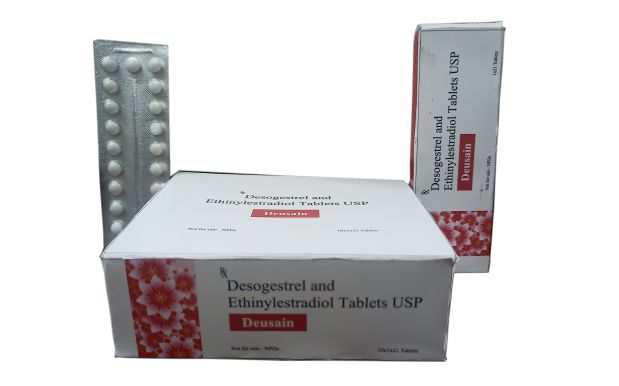Indications and Usage
Prevention of Pregnancy.
Pharmacology
Mechanism of Action:
Desogestrel main therapeutic effect due to its mechanism of action is known to be related to the inhibition of the ovulation in 97% of the cycles. This effect was proven in clinical trials in non-breastfeeding women from which the Pearl failure rate was reported to be of 0.17 per 100 women-years. This result indicated that desogestrel is more efficient when compared to other progestogen-only pills. All the therapeutic effect is produced by a transformation of the endometrium followed by an inhibition of the ovulation due to the suppression of other hormones.
Absorption: After oral administration, desogestrel is rapidly absorbed and it reaches a peak concentration of 2 ng/ml after 1.5 hours. The bioavailability of desogestrel is reported to be in the range of 60-80%
Volume of distribution: The apparent volume of distribution of desogestrel is of 1.5 L/kg. The main metabolite of desogestrel is mainly found bound to albumin and sex-hormone binding globulin. Around 96-98% of the administered dose of desogestrel is found bound to plasma proteins from which 40-70% is found bound to sex-hormone binding globulin.
Metabolism: Desogestrel is rapidly metabolized in the intestinal mucosa and by first-pass hepatic metabolism to form the major metabolite of desogestrel is etonogestrel which is the biologically active metabolite.
Elimination: The elimination of desogestrel is found to be mainly renal corresponding to about 6 times the dose eliminated in the bile. The elimination of desogestrel is only done as the metabolites and not as the unchanged drug and about 85% of the administered dose can be excreted as metabolites after 6-8 daysThe terminal half-life of desogestrel is determined to be of 30 hours.
Ethinylestradiol is a synthetic estrogen that decreases luteinizing hormone to decrease endometrial vascularization, and decreases gonadotrophic hormone to prevent ovulation. It has a long duration of action as it is taken once daily, and a wide therapeutic index as overdoses are generally not associated with serious adverse effects. Combined oral contraceptives suppress ovulation by suppressing gonadotrophic hormone, thickening cervical mucus to prevent the travel of sperm, and preventing changes in the endometrium required for implantation of a fertilized egg. Ethinylestradiol decreases luteinizing hormone, decreasing vascularity in the endometrium. It also increases sex hormone binding globulin.
Absorption: A 30µg oral dose of ethinylestradiol reaches a Cmax of 74.1±35.6pg/mL, with a Tmax of 1.5±0.5h
Protein binding: Enthinylestradiol is 98.3-98.5% bound to albumin in serum8 but also exhibits binding to sex hormone binding globulin.
Metabolism: Drug undergoes glcouridination, sulfation and hydroxylation. Hydroxylated metabolites can be methylated by catechol-O-methyltransferase. The methoxy metabolites can in turn be sulfated or glucuronidated.
Elimination: Ethinylestradiol is 59.2% eliminated in the urine and bile, while 2-3% is eliminated in the feces. Over 90% of ethinylestradiol is eliminated as the unchanged parent drug. A 30µg oral dose has a half-life of 8.4±4.8h
Side Effects
Common side effects include nausea, vomiting, headache, abdominal cramps/bloating, breast tenderness, swelling of the ankles/feet (retaining fluid), or weight change may occur. If any of these effects persist or worsen, tell your doctor or pharmacist promptly. Many women will not have regular periods while taking this medication.
Precaution & Warning
● Hydrochlorothiazide-induced fluctuations in serum electrolyte concentration can occur rapidly and precipitate hepatic coma in susceptible patients. Therefore, the drug should be used with caution in patients with hepatic disease.
● Hyperglycemia, impaired glucose tolerance, and glycosuria can occur during hydrochlorothiazide therapy
● Hydrochlorothiazide-induced fluctuations in serum electrolyte concentration can occur rapidly and precipitate hepatic coma in susceptible patients.
● Hydrochlorothiazide should be used cautiously in patients with renal disease such as severe renal impairment or renal failure.
● Patients with pre-existing hypovolemia or hypotension should have their condition corrected before diuretics are initiated.
● Thiazide diuretics, like hydrochlorothiazide, have been reported to cause pancreatitis.
● Photosensitivity has been reported with thiazide diuretics like hydrochlorothiazide.
● Thiazide diuretics distribute into breast milk, and it has been recommended by some manufacturers that women not nurse while receiving selected thiazide diuretics.
Interaction
Some products that may interact with this drug include:
● Naproxen
● Diphenhydramine
● Venlafaxine
● Methylphenidate
● Pregabalin
● Methylphenidate
● Cholecalciferol
● Cyanocobalamin
● Acetaminophen
● Quetiapine
Contraindication
Do not consume this combination in the following conditions:
● Edema, hypertension
● Headache, migraine
● Depression
● Breast cancer
● Hypercalcemia
● Cervical cancer
● Hypothyroidism, thyroid disease
Disclaimer:The data uploaded is made from content already available on internet.The company holds no right of it and is not responsible for any wrong information.
